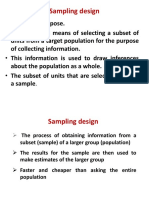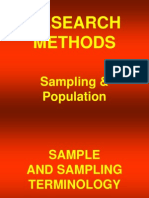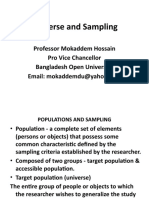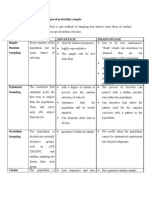0 ratings0% found this document useful (0 votes)
22 viewsSampling
Sampling
Uploaded by
Sir WebsterThis document defines key concepts in sampling, including population, elements, parameters, sample, and sampling frame. It describes probability sampling methods like random sampling, systematic sampling, stratified random sampling, and cluster sampling. It also covers non-probability sampling approaches like convenience sampling, quota sampling, purposive sampling, and snowball sampling. Probability sampling aims to give all population elements an equal chance of being selected to get a representative sample, while non-probability sampling does not ensure representativeness.
Copyright:
© All Rights Reserved
Available Formats
Download as PDF, TXT or read online from Scribd
Sampling
Sampling
Uploaded by
Sir Webster0 ratings0% found this document useful (0 votes)
22 views14 pagesThis document defines key concepts in sampling, including population, elements, parameters, sample, and sampling frame. It describes probability sampling methods like random sampling, systematic sampling, stratified random sampling, and cluster sampling. It also covers non-probability sampling approaches like convenience sampling, quota sampling, purposive sampling, and snowball sampling. Probability sampling aims to give all population elements an equal chance of being selected to get a representative sample, while non-probability sampling does not ensure representativeness.
Original Title
9. Sampling (2)
Copyright
© © All Rights Reserved
Available Formats
PDF, TXT or read online from Scribd
Share this document
Did you find this document useful?
Is this content inappropriate?
This document defines key concepts in sampling, including population, elements, parameters, sample, and sampling frame. It describes probability sampling methods like random sampling, systematic sampling, stratified random sampling, and cluster sampling. It also covers non-probability sampling approaches like convenience sampling, quota sampling, purposive sampling, and snowball sampling. Probability sampling aims to give all population elements an equal chance of being selected to get a representative sample, while non-probability sampling does not ensure representativeness.
Copyright:
© All Rights Reserved
Available Formats
Download as PDF, TXT or read online from Scribd
Download as pdf or txt
0 ratings0% found this document useful (0 votes)
22 views14 pagesSampling
Sampling
Uploaded by
Sir WebsterThis document defines key concepts in sampling, including population, elements, parameters, sample, and sampling frame. It describes probability sampling methods like random sampling, systematic sampling, stratified random sampling, and cluster sampling. It also covers non-probability sampling approaches like convenience sampling, quota sampling, purposive sampling, and snowball sampling. Probability sampling aims to give all population elements an equal chance of being selected to get a representative sample, while non-probability sampling does not ensure representativeness.
Copyright:
© All Rights Reserved
Available Formats
Download as PDF, TXT or read online from Scribd
Download as pdf or txt
You are on page 1of 14
9.
Sampling
Basic Sampling Concept
Definition
• This is the method or process of selecting
certain members, objects, events to
represent the whole group
• But this is not possible due to:
• Time factor
• Cost
• Manageability
Basic Concept in Sampling
• 1. Population: this is the entire group of
persons or objects and events of interest to the
researcher ,
• stipulate inclusion criteria ie eligible criteria, or
distinguishing descriptors
• The population the researcher defines is
referred to as accessible population or study
population
Concepts cont’
• 2. Elements: this is the unit that make up
the total population and from which data is
obtained. This could be people, objects or
events. ie a unit of analysis
• 3. Parameter: a characteristic of the
elements of a population such as the
mean age. This describes a particular
characteristics of the whole population
• 4. Sample: subset of a population
Concepts cont’
• 5. Sampling frame:
• 6 Representative sample: This is a sample
that resembles the population in as many
ways as possible enabling the researcher
to generalise the results: issues to note
are demographic characteristics eg age,
ethnicity etc
Concepts cont’
• 7. Sampling error: this refers to the difference between
the population parameters and sampling statistics.
Although this is unavoidable but a large sampling error
means the sample is not representative of the
population this can be due to the small size of the
sample. Sampling error are due to:
• Chance factor: this is the inclusion of an elements at
the expense of the other and this can be statistically
calculated
• Bias selection: due to over or under representation
• Non-responsive error: for some reason a
respondent does not respond to a measuring
instrument and hence is excluded
Concept cont’
• 8. Sampling bias: this occurs when there
is a difference between sample data and
population data.
• Sources of sampling bias
– Language barrier
– Personal view
– Place of data collection
Sampling approaches
• Probability: this is an approach that gives
each element an equal chance of being
chosen in the sample.
• probability sampling is divided into the
following:
• Random sampling
• Systematic sampling
• Stratified random sampling
• Cluster sampling
Probability Sampling
• Random sampling: This is the most basic approach to
probability sampling that gives all elements in a
population equal chance based on the definition of the
population and sample frame
• Once sample size has been determined allocate
consecutive identification numbers to the elements then
decide on the random selection technique and the
common ones being:
• Fishbowl or lottery: all elements identified and placed in
fish bowl and drawn randomly
• Random number table: pick starting point in the table
and then move horizontally, vertically and then
diagonally each time picking numbers that are in the
population. If number occurs that is not in the
represented population exclude and move on
Probability Sampling cont’
• Systematic sampling: sometimes referred to as
interval sampling where every fth of the
population is selected eg this is simpler and
quicker but depends on the availability of a
complete population list same as random
• The process involves
– Obtain list of the population (N)
– Determine sample size (n)
– Determine the sample interval by dividing the size of
the population by the size of the sample
Probability Sampling cont’
• Stratified sampling: divided into
• Stratified Random Sampling: This is used when
the population is divided into strata ie age and
then selection from each is done using either
random or systematic
• Proportional stratified sample: the sample must
reflect the distribution of the elements to avoid
over sampling one group or event or object. This
requires extensive knowledge of the population
• Disproportional stratified sample: ideal when
finding are not to be generalised across the
group.
Probability Sampling Cont’
• Cluster sampling: this is when the population is
grouped into heterogeneous cluster as
compared to homogenous ones. Ideal when the
whole list of the sample frame is not available or
a large group is involved
• Cluster sampling takes place in stages eg start
with general population then cities, then
progress to residential area and then individual
participants
• Although it tends to contain more error than the
other two it is widely used when the population is
large and widely scattered
Non probability sampling
• This is the method where the researcher
does not know whether all the elements of
the population are included or can be
included giving a zero chance to some
elements
• This is less desirable since it is next to
impossible to generalise the findings
• Used when probability sampling is difficult
to implement or too expensive
Non probability sampling cont’
• Types
• 1. Convenience sampling: This is based on
availability of elements chosen based on researcher’s
convenience: problem – overrepresentation or under
• 2. Quota sampling: this is associated with stratified
sampling but elements chosen based on convenience
• 3. Purposive or judgemental: used when researcher
has sufficient knowledge of the population e.g. days of
high and low activity
• 4.Snowball sampling: used when it is difficult to
locate element hence once few are found then these
are used to locate and identify others
You might also like
- Sampling DesignDocument49 pagesSampling DesignSanthosh Acharya67% (3)
- Lecture 9 Sampling Techniques LectureDocument30 pagesLecture 9 Sampling Techniques Lectureephraimsmart11No ratings yet
- SamplingDocument36 pagesSamplingHaneen Jehad Um MalekNo ratings yet
- Unit 3Document46 pagesUnit 3Khari haranNo ratings yet
- 3 Unit: SamplingDocument25 pages3 Unit: SamplingVirupaksha GoudNo ratings yet
- Sampling Meaning of Basic TermsDocument5 pagesSampling Meaning of Basic TermsSpatika MgNo ratings yet
- Research Methods: Sampling & PopulationDocument48 pagesResearch Methods: Sampling & PopulationAli Imran LodhiNo ratings yet
- Sampling 2Document9 pagesSampling 2halayehiahNo ratings yet
- Sampling 8.3.16Document40 pagesSampling 8.3.16Arham SheikhNo ratings yet
- Sampling Lecture SlideDocument27 pagesSampling Lecture SlideLEHLABILE OPHILIA TSHOGANo ratings yet
- Module 9Document13 pagesModule 9kotharipragati7No ratings yet
- Sample and Sampling TerminologyDocument49 pagesSample and Sampling Terminologyalone_01100% (1)
- 2.1 SamplingDocument44 pages2.1 SamplingVishal SharmaNo ratings yet
- 2.1.1 SamplingDocument46 pages2.1.1 Samplinguday.behl7No ratings yet
- Introduction To Management Chapter One Rift Valley UniversityDocument31 pagesIntroduction To Management Chapter One Rift Valley Universitymuazmiftah76No ratings yet
- Sampling Design & Different Types of Sampling TechniquesDocument41 pagesSampling Design & Different Types of Sampling TechniquesSajid ShaikhNo ratings yet
- Topic 7Document46 pagesTopic 7honathapyarNo ratings yet
- The Concept of SamplingDocument8 pagesThe Concept of SamplingDeep KatariaNo ratings yet
- RESEARCH PROCESS-SAMPLING1Document52 pagesRESEARCH PROCESS-SAMPLING1Enockay MwemaNo ratings yet
- Related StudiesDocument6 pagesRelated StudiesRochelle TabernaNo ratings yet
- SAMPLE AND SAMPLING TECHNIQUE pptDocument46 pagesSAMPLE AND SAMPLING TECHNIQUE pptvivekkumarmux7788No ratings yet
- Data SamplingDocument18 pagesData SamplingsrivantaeNo ratings yet
- Sampling Nursing ResearchDocument16 pagesSampling Nursing ResearchLawrence Rayappen100% (3)
- Chapter Five SamplingDocument33 pagesChapter Five Samplingmurtialiyi8No ratings yet
- 6 SamplingDocument24 pages6 SamplingHê lô Thanh hà Tạ :DNo ratings yet
- Research MethodologyDocument36 pagesResearch MethodologyJeca CodmNo ratings yet
- SamplingDocument21 pagesSamplingseemapawar749No ratings yet
- Course 5 - Research Design - Sampling DesignDocument46 pagesCourse 5 - Research Design - Sampling Designteuku ismaldyNo ratings yet
- Business Research Method: Unit 4Document17 pagesBusiness Research Method: Unit 4Prince SinghNo ratings yet
- Universe and Sampling: Professor Mokaddem Hossain Pro Vice Chancellor Bangladesh Open UniversityDocument24 pagesUniverse and Sampling: Professor Mokaddem Hossain Pro Vice Chancellor Bangladesh Open UniversityNajneen Jahan NehaNo ratings yet
- Quantitative Research Design and Sampling MethodsDocument20 pagesQuantitative Research Design and Sampling MethodsMagnolia KhineNo ratings yet
- SAMPLINGDocument19 pagesSAMPLINGseenubarman12No ratings yet
- Research Methods For Business & Management: Summer Semester - 2020/2021 Module Fourteen SamplingDocument27 pagesResearch Methods For Business & Management: Summer Semester - 2020/2021 Module Fourteen SamplingOmar HadeNo ratings yet
- Research ProcessDocument23 pagesResearch ProcessRushin KothariNo ratings yet
- SamplingDocument23 pagesSampling119936232141No ratings yet
- ArticleDocument7 pagesArticleAiman Aslam KhanNo ratings yet
- Research Methodology: Chapter 11-SamplingDocument28 pagesResearch Methodology: Chapter 11-SamplingSerah JavaidNo ratings yet
- Sampling (Method)Document31 pagesSampling (Method)kia.reshuNo ratings yet
- Research Methods & MaterialsDocument78 pagesResearch Methods & MaterialsSintayehuNo ratings yet
- Sampling - 2019Document38 pagesSampling - 2019Kudzy MatadiNo ratings yet
- A Summary of The Various Types of Probability SampleDocument4 pagesA Summary of The Various Types of Probability SamplekiranaishaNo ratings yet
- Sampling DesignDocument57 pagesSampling DesignGetachew DemissieNo ratings yet
- Chapter - 4 2015Document33 pagesChapter - 4 2015Yona TsegayeNo ratings yet
- Sampling and Sample DistributionDocument22 pagesSampling and Sample DistributionMitika MahajanNo ratings yet
- Presentation On Sampling: Group MembersDocument42 pagesPresentation On Sampling: Group MembersShahid Ali DurraniNo ratings yet
- Chapter 3Document40 pagesChapter 3k3080017No ratings yet
- Sampling and Sampling DistributionDocument22 pagesSampling and Sampling DistributionMr Bhanushali100% (1)
- Lecture 7: Sampling Techniques: Lecturer: Mr. Abdirisak Suleiman IbrahimDocument22 pagesLecture 7: Sampling Techniques: Lecturer: Mr. Abdirisak Suleiman IbrahimAbdifatah MuhumedNo ratings yet
- SamplingDocument59 pagesSamplingpooja100% (1)
- Lec. 7 SamplingDocument55 pagesLec. 7 SamplingSarvesh JP NambiarNo ratings yet
- Sampling and Sampling DistributionsDocument27 pagesSampling and Sampling DistributionspranayNo ratings yet
- Lesson 6Document29 pagesLesson 6sadafilyasNo ratings yet
- Sample Size For Surveys: Dr. Muna Hassan MustafaDocument32 pagesSample Size For Surveys: Dr. Muna Hassan MustafaMuna Hassan MustafaNo ratings yet
- Sampling: SR - Lecturer C.P.RashmiDocument18 pagesSampling: SR - Lecturer C.P.RashmiShreyansh PriyamNo ratings yet
- 9 Sample DesignDocument42 pages9 Sample Designcesar suarezNo ratings yet
- SamplingDocument81 pagesSamplingShweta ChaudharyNo ratings yet
- Presentation 1Document37 pagesPresentation 1Afia TawiahNo ratings yet
- 10-Population and SamplingDocument34 pages10-Population and SamplingNuwasasira BrianNo ratings yet
- By Okite MosesDocument33 pagesBy Okite MosesBanolka NobNo ratings yet
- Data AnalysisDocument10 pagesData AnalysisSir WebsterNo ratings yet
- Quantitative Data AnalysisDocument22 pagesQuantitative Data AnalysisSir WebsterNo ratings yet
- Qualitative Data AnalysisDocument10 pagesQualitative Data AnalysisSir WebsterNo ratings yet
- 5.literature ReviewDocument15 pages5.literature ReviewSir WebsterNo ratings yet
- 4.ethics in ResearchDocument10 pages4.ethics in ResearchSir WebsterNo ratings yet
- Worksheet 10: Straight Lines and Quadratic Equations: Extended Revision Exercises: AlgebraDocument4 pagesWorksheet 10: Straight Lines and Quadratic Equations: Extended Revision Exercises: Algebramk hatNo ratings yet
- Ecostruxure Control Expert With Topology ManagerDocument11 pagesEcostruxure Control Expert With Topology Managerharold_anilloNo ratings yet
- 2024 Business Management 1 Semester 2 Group AssignmentDocument7 pages2024 Business Management 1 Semester 2 Group Assignmentlesedimabote01No ratings yet
- Asa5508 k9 DatasheetDocument7 pagesAsa5508 k9 DatasheetsindicatoNo ratings yet
- HSC - Ict - 2023 - 2Document6 pagesHSC - Ict - 2023 - 2kocada7620No ratings yet
- Lec 01 - Digital Systems & Binary NumbersDocument83 pagesLec 01 - Digital Systems & Binary NumbersEsmail AttaNo ratings yet
- Apxvll13 CDocument1 pageApxvll13 CAntonio DrednoudNo ratings yet
- Vanderbilt University ES 140x EE Introduction To Engineering Electrical Engineering Module Fall 2021Document3 pagesVanderbilt University ES 140x EE Introduction To Engineering Electrical Engineering Module Fall 2021Siyuan ChenNo ratings yet
- Remote Procedure Calls-Part I: Distributed Systems CS 15-440Document31 pagesRemote Procedure Calls-Part I: Distributed Systems CS 15-440anikatahsinNo ratings yet
- GT I9515l Tshoo 7Document132 pagesGT I9515l Tshoo 7MayconNo ratings yet
- FT-22300500MP (Smart 500 MP) - enDocument2 pagesFT-22300500MP (Smart 500 MP) - enArahman RamadhanNo ratings yet
- Oggetto: Limiti Ottiche SFP & XFP: Assistenza Tecnica System TestDocument2 pagesOggetto: Limiti Ottiche SFP & XFP: Assistenza Tecnica System Testroswind77No ratings yet
- Samsung PDFDocument15 pagesSamsung PDFJelena Bieber100% (1)
- Catálogo de Peças Ecavadeira HYUNDAI R140Document930 pagesCatálogo de Peças Ecavadeira HYUNDAI R140Tiago Soares100% (4)
- BSBPMG621 Task 2 v1.1Document42 pagesBSBPMG621 Task 2 v1.1Aroosa MirzaNo ratings yet
- RPS67.118.2 06/08 Version - A: Repair Parts Sheet RC-Cylinders 15-Ton Single-Acting 0-700 BarDocument2 pagesRPS67.118.2 06/08 Version - A: Repair Parts Sheet RC-Cylinders 15-Ton Single-Acting 0-700 BarGuillermo Andres Gomez RamirezNo ratings yet
- Anti-Theft Solution of Lithium-Ion Battery For TelecomDocument13 pagesAnti-Theft Solution of Lithium-Ion Battery For TelecomHafzal HaniefNo ratings yet
- Basic Charts and Multidimensional VisualizationDocument33 pagesBasic Charts and Multidimensional VisualizationiyshwaryaNo ratings yet
- Módulo 9 - Communication in The Professional WorldDocument5 pagesMódulo 9 - Communication in The Professional WorldLeocádia Cardoso FerreiraNo ratings yet
- MeTRON 05 DDocument2 pagesMeTRON 05 DDaerenmind AngNo ratings yet
- Intro To Cauchy Sequences (Calculus)Document4 pagesIntro To Cauchy Sequences (Calculus)Максим БекетовNo ratings yet
- 2019 Schwartz Intra Rater and Inter Rater Reliability of The Rapid Entire Body Assessment (REBA) ToolDocument6 pages2019 Schwartz Intra Rater and Inter Rater Reliability of The Rapid Entire Body Assessment (REBA) ToolJohannes SchützNo ratings yet
- Unit 5Document6 pagesUnit 5nagarajurayabarapu08No ratings yet
- TSA Series BrochureDocument24 pagesTSA Series BrochureasdgsdfgNo ratings yet
- Eaton 9sx (AP) UpsDocument68 pagesEaton 9sx (AP) Upssalman.deltasindoNo ratings yet
- Top Hacker Shows How Its DoneDocument2 pagesTop Hacker Shows How Its DoneJohn Adrian RegaladoNo ratings yet
- 01 CVL412a EE4 Quiz No. 1 SolutionDocument8 pages01 CVL412a EE4 Quiz No. 1 SolutionEro RosalNo ratings yet
- Lesson+2 1+Input+DevicesDocument25 pagesLesson+2 1+Input+DevicesLeen AlhaleesNo ratings yet
- P22Document9 pagesP22Aastha JainNo ratings yet
- Inverting Operational Amplifier - The Inverting Op-Amp PDFDocument10 pagesInverting Operational Amplifier - The Inverting Op-Amp PDFashik ahmedNo ratings yet






























































































